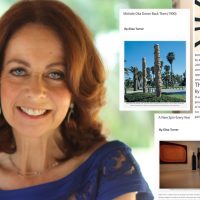Elisa Turner: Art Critic

ELISA TURNER is an award-winning art critic and art journalist. She is a member of the International Association of Art Critics, U.S. Section, and ArtTable, a national organization for women in visual arts professions. Her art writing has appeared in ARTnews, Miami Herald, Artburstmiami, Art+Auction, Arte Al Dia, Art Circuits, Delicious Line, Hamptons Art Hub, ArtSpeak, Miami Rail and other publications. As a blogger she has posted many of her previous Miami Herald articles on http://artcircuitsartcentric.blogspot.com/ and www.elisaturnerartcrit.blogspot.com. In 2009 she began teaching at Miami Dade College; she has guest-lectured at University of Miami and New World School of the Arts. Drawing on her experience and research in Miami Herald archives, she wrote the foreword tracing the history of the Miami art scene from the early 1980s to 2006 for Miami Contemporary Artists by Julie Davidow and Paul Clemence, published by Schiffer Books. It was launched at Art Basel Miami Beach 2007. Her career at the Miami Herald began in 1986 and continued for 21 years. From 1995 to 2007, she was primary art critic for the Miami Herald, with international assignments to Havana Biennial, Haiti, Venice Biennial, and Art Basel in Basel, Switzerland. As Miami correspondent for the award-winning ARTnews print magazine, she has written reviews, news reports, feature stories, and profiles of prominent figures in Miami’s art community. She holds an M.A. in Comparative Literature, focusing on international cultural studies, from University of North Carolina at Chapel Hill. And she earned a BA in English from DePauw University. Her background reflects wide-ranging experience in writing, teaching, and public speaking. In 2019 she received the Annual Chapter Leadership Award from Florida Chapter of ArtTable. Other awards include President’s Volunteer Service Award from Miami Dade College in 2012 and Society of Professional Journalists Sunshine State Award in 2006.
The videos below are organized by Success Factor and run between 30 seconds and 4 minutes. Click on any video. You must be connected to the Internet to view the videos.
EXPOSURE TO BROAD INFLUENCES: 2:21 min.
CRITICAL THINKING: 1:39 min.
SEIZES OPPORTUNITIES: 0:54 sec.
SEIZES OPPORTUNITIES: 1:07 min.
DEVELOP A VOICE: 1:56 min.
SERENDIPITY: 1:18 min.
CREATES A UNIQUE PERSONAL BRAND: 1:27 min.
PERSEVERANCE FURTHERS: 0:48 sec.
CRITICAL THINKING: 2:51 min.
UNDERSTANDS THE BUSINESS OF ART: 1:37 min.
PERSEVERANCE FURTHERS: 1:15 min.
OVERCOMES CHALLENGES TO SUCCEED: 3:29 min.
PERSEVERANCE FURTHERS: 3:51 min.
SERENDIPITY: 1:02 min.
RESILIENCE: 2:44 min.

